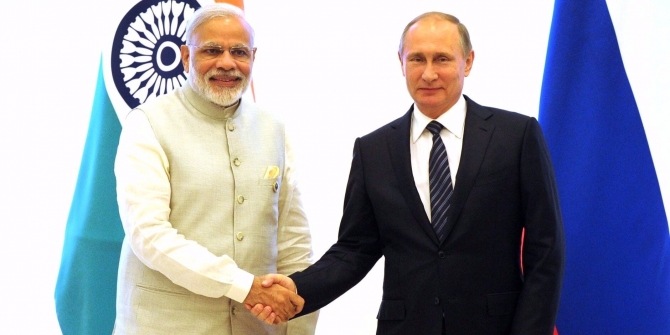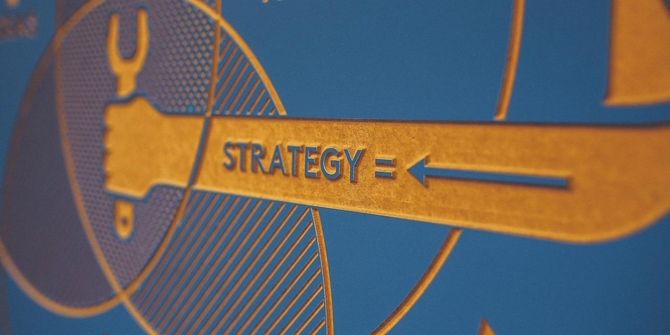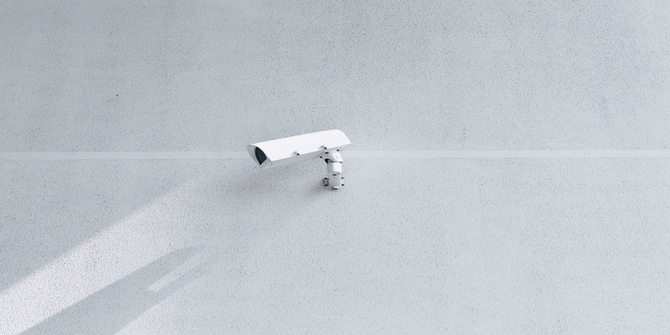 This New Year, Indian Prime Minister Narendra Modi vowed to strengthen India-Russia relations. From several senior level bilateral meets in 2017 to increasing trade, India-Russia relations have already regained momentum. Apart from shared worldview and strong military-technical partnership, the two countries need to now look at strengthening economic and cultural relations writes Uma Purushothaman.
This New Year, Indian Prime Minister Narendra Modi vowed to strengthen India-Russia relations. From several senior level bilateral meets in 2017 to increasing trade, India-Russia relations have already regained momentum. Apart from shared worldview and strong military-technical partnership, the two countries need to now look at strengthening economic and cultural relations writes Uma Purushothaman.
In 2017, India and Russia started paying more attention to their bilateral relations, reviving a stagnant relationship and recovering some of the momentum that was lost over the past few years.
The first factor for this was a change in international politics led by an unpredictable United States under President Donald Trump and a revisionist, rich China. The second was Russia’s decreased influence, partly because of its sagging economy, and its inability to project a positive narrative.
Looking Back
Earlier, the distrust between the US and Russia had tempered India’s enthusiasm for better ties with the latter. Estrangement with the US had pushed Russia towards closer relations with China as is evident from their close economic relationship, massive energy deals, Russia’s decision to cooperate with China’s Belt Road Initiative and its reopening of sale of high-tech military equipment to China. This naturally aroused Indian insecurities pushing India closer to the US, since China has been the primary security challenge for India.
For Russia, ties with China are vital because they give Russia latitude in dealing with the West, while also bringing in much needed investments. In addition, China and Russia agree on many multilateral issues, including the Syrian and North Korean crises.
However, Indian strategists fear a China-Pakistan-Russia axis. For them, Russia’s transfer of Mi-35 M attack helicopters to Pakistan in 2017 and its attempts to settle the Afghanistan issue is a cause for concern. From Russia’s point of view, Pakistan remains a natural market for its weapons, primarily because arms sales form a small but substantial revenue source that accounts for over 3 per cent of total employment in Russia. Therefore, Russia does not understand India’s unhappiness over the sale of a few helicopters, that Russians believe are unlikely to be used against India, to Pakistan. Especially because Russia is engaged in the supply to and joint production of lethal weaponry with India, which is more than likely to be used against Pakistan.
Moreover, Moscow saw no harm in diversifying its own list of weapons markets when India has diversified its basket of defence suppliers. In 2016, India signed the Logistics Exchange Memorandum of Agreement (LEMOA) with the US, Russia’s major threat, and not with Russia, its primary defence partner. The Indo-US partnership was seen by some Russian strategists as a betrayal and they were concerned about India’s support to Russia.
On the issue of the Afghan crisis, while Russia appreciates India’s concerns about Pakistan’s intentions in Afghanistan, it also believes that there cannot be a solution without involving Pakistan and the Taliban. India too understands this, but the differences are in the detail: Russia, unlike India, views Afghanistan through the prism of its rivalry with the US.
Going Forward
However, things are now changing. The leadership in both countries seem to have realised the value of maintaining their partnership and seem to be taking steps towards strengthening the relationship. This is evident from the spurt in the number of senior level bilateral visits as well as interactions at multilateral forums like RIC, BRICS and SCO. In fact, there have been around 40 bilateral visits by senior Russian and Indian officials in 2017 alone. Added to this is an astonishing 22 per cent leap in bilateral trade in 2016-17.
Restoring the lost momentum in ties has been relatively easy because of one reason: there are no fundamental disagreements between Moscow and New Delhi, unlike their relations with the other major powers. The relationship provides both countries with crucial strategic space vis-à-vis other great powers. Both countries aspire for a multipolar world, in which they are significant players.
It is important to note here that Prime Minister Narendra Modi’s only phone call this year to another world leader to exchange New Year greetings was to President Vladimir Putin.
On issues of mutual and paramount importance both countries have consistently supported each other. Some recent instances include India’s refusal to join the US-led sanctions on Russia and Russia’s unwavering support for India’s membership into the NSG. Moscow and New Delhi both voted against the US on the Jerusalem resolution at the UN. More importantly, only last week, India voted against a UN General Assembly resolution which condemned the human rights situation in Crimea and Sevastopol, thus declaring its solidarity with Russia. In fact, both the recent UN votes appear to signal some differences with the US on issues that the Trump administration considers its core interests: Israel and Ukraine.

Moreover, Russia remains India’s primary defence supplier (despite having no formal military treaty or alliance) and is likely to remain so for at least the next couple of decades. India, on its part, is Russia’s biggest market for defence equipment. India’s nuclear submarine programme would not have been possible without Russian help. For all the talk about the Russia-China partnership, Russia supplies offensive weapons to India although it is fully aware that the principal target of India’s nuclear deterrence programme is China.
Shared worldview and a strong military-technical partnership aside, Russia and India need to find new areas of cooperation to preserve their strategic partnership. In today’s world, it is economics that drives and sustains relationships. The two countries need to develop a broader economic relationship through joint development and manufacturing for export — particularly of defence equipment — to other countries. This would help India develop its defence industrial base and also dovetail into its “Make in India” initiative. The two governments are aware of this lacunae in their relations and are taking concrete steps to strengthen trade relations. In fact, in December last year, the India-Russia Inter-Governmental Commission agreed to create a Working Group on agriculture and pharmaceuticals, and decided to expedite the implementation of the Green Corridor for exchange of pre-arrival data between Customs Administrations of the two countries.
Opportunities ahead
There are other areas where India-Russia economic partnerships can be strengthened. Diamond trade is an area where the two countries could improve cooperation. India has skills in diamond polishing and Russia has resources of diamonds. Once the Arctic trading routes open and the International North South Transport Corridor (INSTC) and the India-Eurasian Economic Union FTA fructify, trade relations could deepen.
Nuclear cooperation is yet another area with high potential. Russia faces a serious demographic crisis and to diversify and modernise its economy it will need skilled and low-skilled labour, which its “near abroad” alone cannot provide. Going forward, it might be a good for the two countries to think of ways in which Indian labour can contribute to the Russian economy. As West Asia can show, Indian labour are loath to intervene in domestic political affairs, something which would suit Russia’s current regime.
Cultural cooperation has been minimal since the end of the Cold War, the Hare Krishna mission’s Russian devotees, notwithstanding. Introduction of more scholarships and investment in exhibitions and cultural festivals could benefit both countries. Tourism is yet another sector that can be tapped: flights between Moscow and Delhi are barely 6.5 hours long and cost just over a thousand dollars and are, therefore, affordable and accessible to the middle class in both countries.
For now, India-Russia relations seem to be out of the woods. They seem to have finally made the transition from a nostalgia-driven relationship to a more transactional one. However, the political leadership in both countries should seize the moment and work towards a more sustainable strategic partnership.
This article gives the views of the authors, and not the position of the South Asia @ LSE blog, nor of the London School of Economics. Please read our comments policy before posting.
About The Author
 Uma Purushothaman teaches International Relations at the Central University of Kerala, India. Her current work focuses on India’s relations with the great powers. She tweets @Uma_Vinay
Uma Purushothaman teaches International Relations at the Central University of Kerala, India. Her current work focuses on India’s relations with the great powers. She tweets @Uma_Vinay







